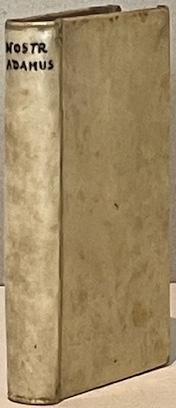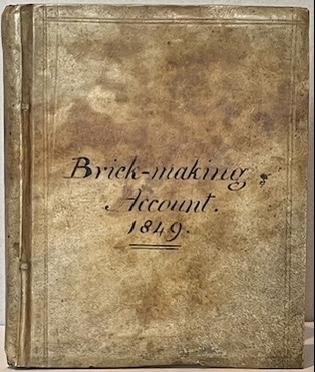
MANUSCRIPT BRICKYARD CAPITAL ACCOUNT.
(STRICKLAND, Henry Eustatius). pp. 10 leaves of accounts and 2 leaves of journal. The rest of the book is blank. 4to. Full vellum much browned. It would appear that Henry Eustatius Strickland, who built Apperley Court, had his own brick works as under Received (Season 1850) Dr H E Strickland June 17 From Self. Strickland built a chapel at Apperley which was comnpleted in1857. The journal at the back of the book chronicles, in brief, the creation of the brickworks.This branch of the Strickland family came from East Yorkshir. Henry's son Hugh was the renowned geologist Hugh Edwin Strickland, who was killed by a passenger train while avoiding a coal train.- $368
- $368
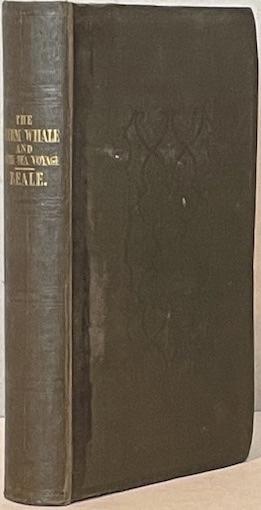
THE NATURAL HISTORY OF THE SPERM WHALE: . To which is added, a sketch of a South-Sea Whaling Voyage.
BEALE, Thomas, Surgeon. pp. 12, (ii) of subscribers, 393, (iv) of adverts dated 1838. Frontis, 2 plates. 8vo in 12s. Original cloth, spine relaid, recased slightly tightly, small section cut from half title. With the bookplate of Sir Edmund Giles Loder. 2nd edition- $1,471
- $1,471
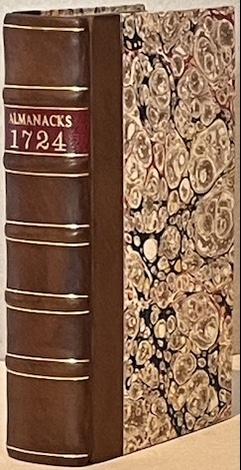
THE LADIES DIARY or, The Woman’s Almanack; GREAT NEWS FROM THE STARS: or, an Ephemeris; MERLINUS ANGLICUS JUNIOR: or The Starry Messenger; EPHMEPIS: or, A Diary Astronomical, Astrological, Meteorological; VOX STELLARUM: Being a Loyal Almanack; MERLINUS LIBERATUS: An Alamanack; PARKER’S EPHEMERIS The Thirty Fifth Impression; THE COELESTIAL DIARY: or an Ephemeris Sixth Impression; POOR ROBIN An Almanack after the Old and New Fashion;APOLLO ANGLICANUS: The English Apollo; PANTERPE; ID EST DELECTARE: or, an Almanack and an Ephemeris; GREAT BRITAIN’S DIARY: or, The Union- Almanack; John Wing’s ALMANACK; THE BRITISH TELESCOPE: being an Ephemeris of the Coelestial Motions, with an Almanack.
ALMANACKS. 14 Almanacks all for 1724, all published in London. 8vo. Modern contemporary style quarter calf, marbled boards, new endpapers. Slightly tight binding.- $662
- $662

Harry Potter and the The Deathly Hallows
ROWLING, J.K. (born 1965), [COCKCROFT, Jason, illustrator] [Children's Fantasy] FIRST EDITION, first impression. Octavo (21 x 14cm), pp.607 [1]. Publisher's pictorial paper over boards, with the matching dust-jacket illustrated by Cockcroft, priced at £17.99. A near fine copy showing just a touch of light handling. The final Harry Potter adventure. Philip Errington; J.K. Rowling. A Bibliography (London, Bloomsbury, 2017), A14(a).- $127
- $127
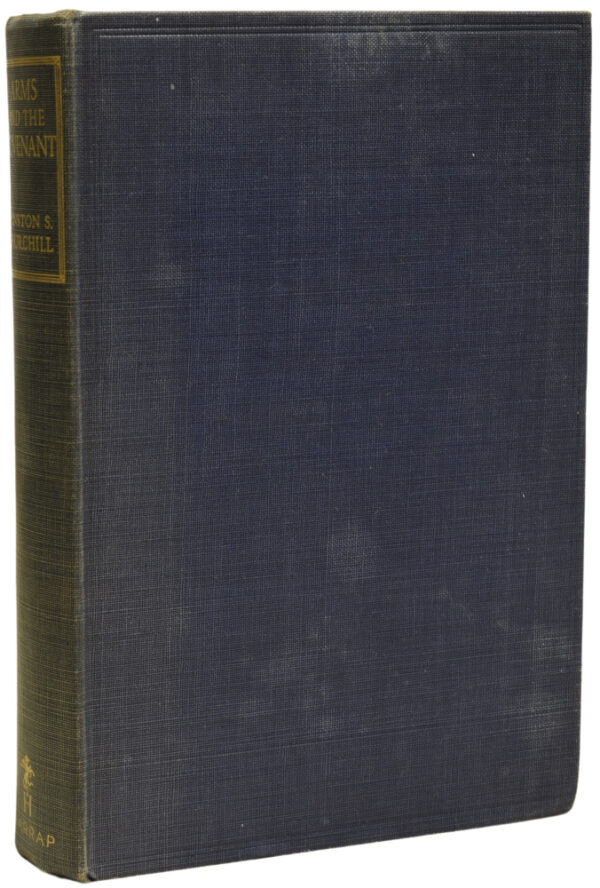
Arms and the Covenant. Speeches by the Right Hon. Winston S. Churchill, C.H, M.P., Compiled by Randolph S. Churchill
CHURCHILL, Winston S. (1874-1965) [Politics] FIRST EDITION, First Impression. Octavo (23 x 17cm), pp.466 [2]. With a frontispiece photograph of Winston Churchill. In publisher's blue cloth with gilt titles to spine. Top edge blue. One of just 5000 copies from the original print-run. Contents clean. First and final leaf of text block toned as usual, edges and covers lightly marked. Very good indeed. A volume of Churchill's speeches on National Defence and Foreign Affairs. The US version, entitled 'While England Slept' was published later in September 1938. Langworth p.192.- $394
- $394
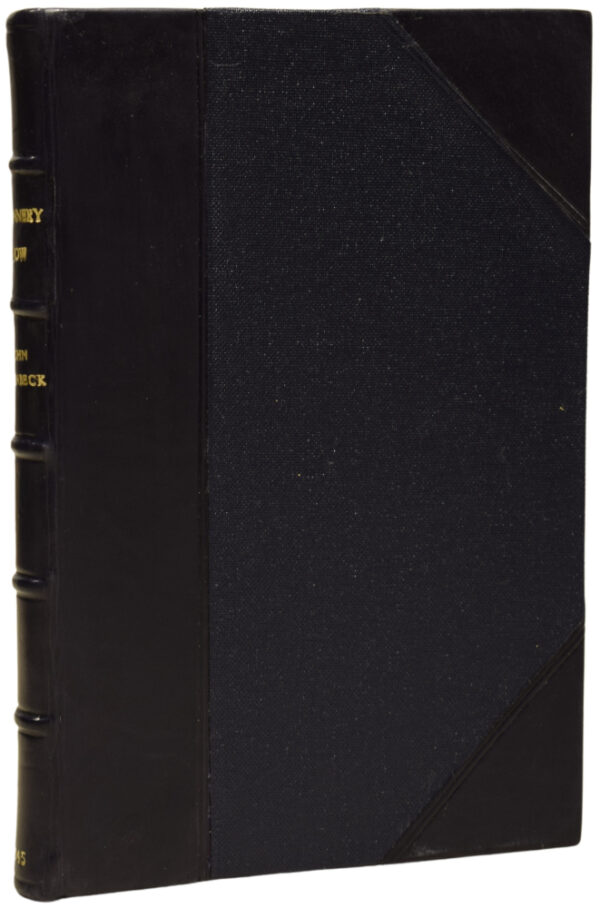
Cannery Row
STEINBECK, John (1902-1968) [American literature] LEATHER-BOUND FIRST UK EDITION, first impression. Octavo (20 x 14cm), pp.136. Elegantly bound in navy blue half calf over the matching cloth boards, raised bands and gilt titles to spine. The pages show brightly bearing in mind they have been printed on war economy standard paper, some slight marking to the edges; externally fine. A clean copy in a handsome recent leather binding. The classic depression-era novella set in a run-down street of sardine canneries in Monterey, California, being a story of misfits, death and loneliness in the aftermath of World War II.- $234
- $234
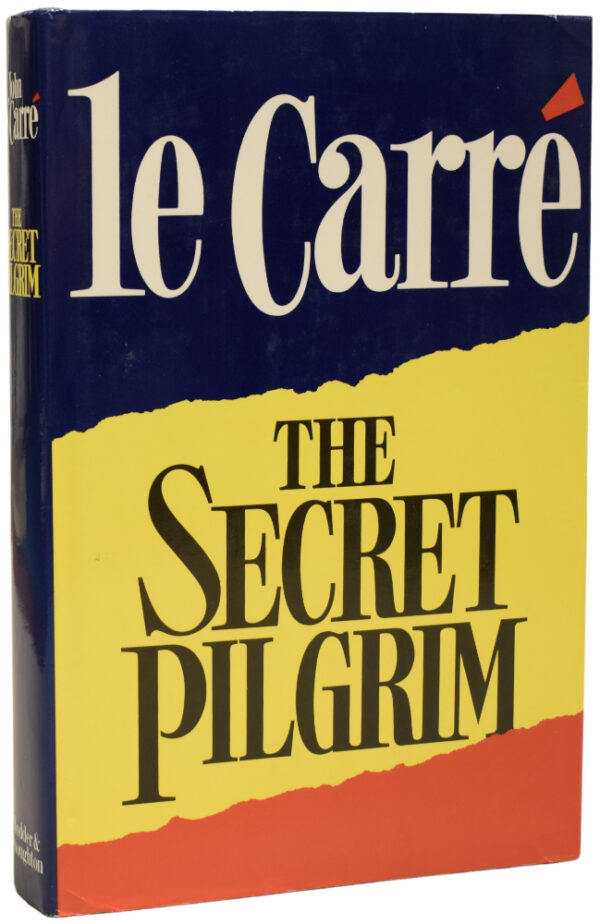
The Secret Pilgrim
LE CARRÉ, John [pseudonym of David John Moore CORNWELL] (1931-2020) [Spy thriller] SIGNED FIRST EDITION, first impression. Octavo (24 x 16cm), pp.[8] 335 [9]. SIGNED by the author in black ink to the title page. Publisher's purple cloth with gilt titles to spine and blue endpapers. With the blue, yellow and red dust-jacket, priced at £14.95. A crisp, fine copy. An espionage novel with George Smiley in a supporting role.- $194
- $194
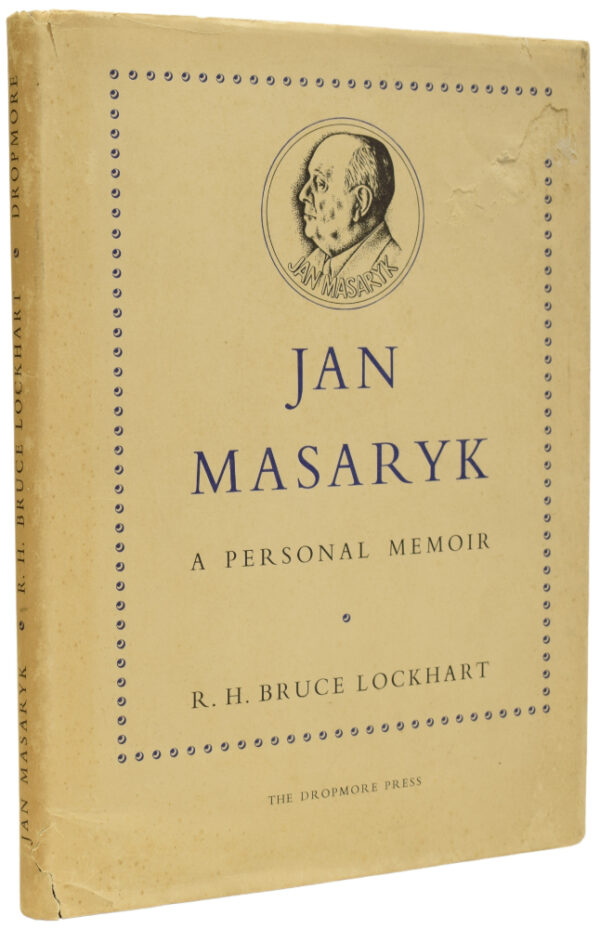
Jan Masaryk. A Personal Memoir
[Ian Fleming association] BRUCE LOCKHART, [Sir] R.H. [Military history /politics / espionage] LIMITED EDITION. One of five hundred copies. Quarto (27 x 20cm), pp.viii;80; [4], printed on hand-made cream wove paper, title and colophon printed in two colours. With fine colour illustration of the Masaryk Memorial Medal, 1948. Original full blue buckram, gilt, t.e.g., illustrated dust-wrapper priced £1, 10s, 0d. A stylish and expensive book for the time. Contents clean. A fine copy in near fine wrapper with small scuff to front panel. An elegant production from the publishing house run by Ian Fleming (renamed Queen Anne Press shortly after this release). Later owned by Fleming's bibliographer Jon Gilbert (also published by QAP). A record of their wartime friendship. Bruce Lockhart was a British diplomat, journalist, author, and secret agent. He was posted to Moscow with agent Sidney Reilly ('Ace of Spies'). His 1932 book Memoirs of a British Agent became an international best-seller, chronicling his experiences in Russia in 1918 following the Bolshevik Revolution. Masaryk was the Foreign Minister of the Czechoslovakian Government-in-exile who made regular BBC broadcasts from London to occupied Czechoslovakia. Masaryk's wartime speeches made him a national hero. Following liberation of his country, he remained Foreign Minister during the volatile immediate post-war years, with Czech communism on the rise, and the country's dealing of arms to Israel during the 1948 Arab-Israeli War. In March 1948 Masaryk was found dead in his pyjamas, having fallen from his balcony. The Ministry of the Interior claimed it was suicide but it was widely assumed he was murdered at the behest of the nascent Communist government. A 1968 investigation could not exclude murder, and an inquest following dissolution of Czechoslovakia concluded that he had been executed. Gilbert, pp.638, 663.- $201
- $201
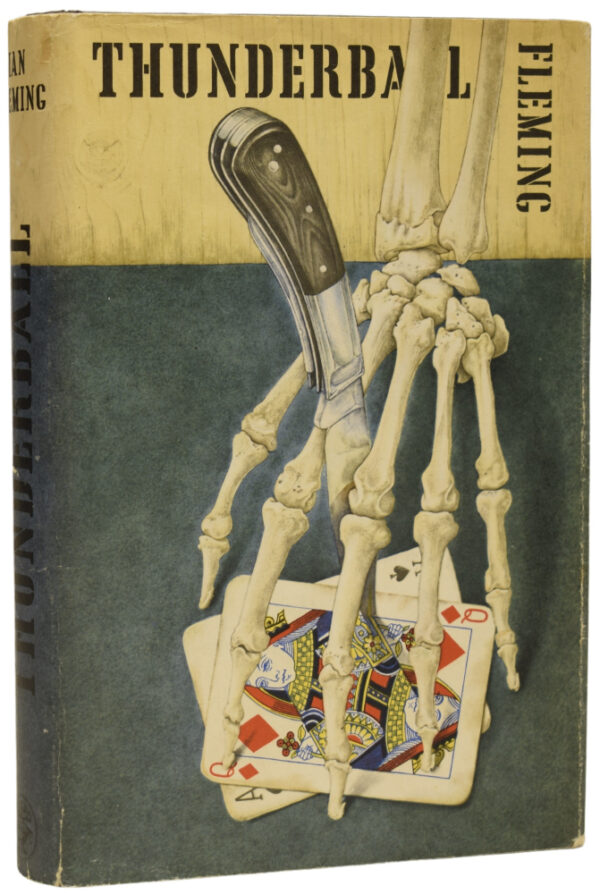
Thunderball
FLEMING, Ian Lancaster (1908-1964) [Spy thriller] FIRST EDITION, fifth impression, bibliographer's copy. Octavo (19 x 13cm), pp.254; [2], bank. Publisher's cloth-effect paper over boards with embossed skeleton hand design to upper board, gilt titles to spine, dust-wrapper illustrated by Richard Chopping priced at £4.95 via publisher's label. Ex-library copy with expected handling and wear, although quite presentable. Faint (partially erased) institutional stamp to copyright page else clean within, some splashing to foot of page edges, jacket with very little wear. Shows well. The majority of Cape's James Bond hardcover reprints were taken into the lending library system to replace existing well-worn stock. From the comprehensive James Bond collection assembled by Jon Gilbert (pencilled notes and signature within). His comprehensive guide to the works of Ian Fleming (2012) won the 16th Breslauer Prize for bibliography. Gilbert A9a (5).- $127
- $127

A Wanted Man. A Jack Reacher Novel
CHILD, Lee [pseudonym of GRANT, James Dover] (born 1954) [Thriller] SIGNED LIMITED EDITION. Octavo (24 x 16cm), pp.408. Number 25 of just 100 copies thus, SIGNED by the author in black ink to limitation page. Publisher's green quarter cloth, with gilt titles to spine and marbled paper over boards. Lilac endpapers. Smudge to fore-edge, either a production fault or transit mark. A fine, as-new copy. The seventeenth Jack Reacher novel. First published in 2012, this special edition contains a new introduction by the author. Lee Child has received multiple nominations for the prestigious Ian Fleming Steel Dagger, recognising best thriller of the year, and won the CWA's Diamond Dagger for a writer of outstanding body of crime fiction. Two blockbuster movies have been made from the Jack Reacher thrillers, plus the acclaimed Amazon Prime television series 'Reacher'.- $201
- $201

H.M.S. Cossack, 1958-1959.
FAR EAST STATION. Sole edition, signed by the ship's captain, David Seely, at the foot of his introduction. In 1959, Cossack completed a 15-year term of service in East Asia. This celebration of its last commission, during which it was stationed in Singapore, Hong Kong, and Japan, is unrecorded in institutions. Seely (1920-2011), the godson of Winston Churchill and of the future Edward VIII, fought in the Second World War and later in Malaya, commanding HMS Ajax between 1964 and 1965 and being mentioned in despatches. In 1966, he inherited the title Baron Mottistone and retired from naval service. Between 1992 and 1995, he was governor of the Isle of Wight. The text is split into a pictorial record of the commission and "not too factual departmental reports and sporting activities" (p. 4), enriched by humorous line drawings. Quarto. Original illustrated boards, red cloth backstrip, front cover lettered in black, endpapers renewed. Illustrations, maps, and advertisements throughout. Miniscule blue ink cross in main photo on p. 11. Boards stained and worn, one corner repaired, small losses at foot of first leaf and lower corner of p. 101, text unaffected: a very good copy.- $869
- $869
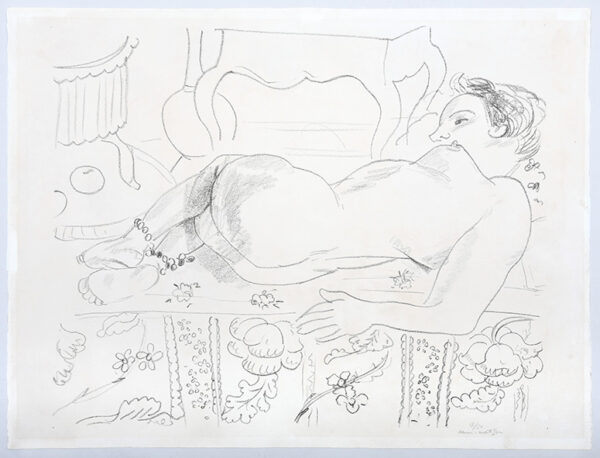
Nu couché sur sol fleuri.
MATISSE, Henri. Edition of 50. Signed and numbered in pencil lower right by the artist. Duthuit 503 Lithograph on Vélin d'Arches watermarked paper. Image size: 45 x 56 cm. Sheet size: 50.5 x 66 cm. Framed size: 86.6 x 101.1 cm. Paper lightly age toned otherwise in excellent condition. Presented in a decorative wooden frame with conservation acrylic glazing.- $33,429
- $33,429
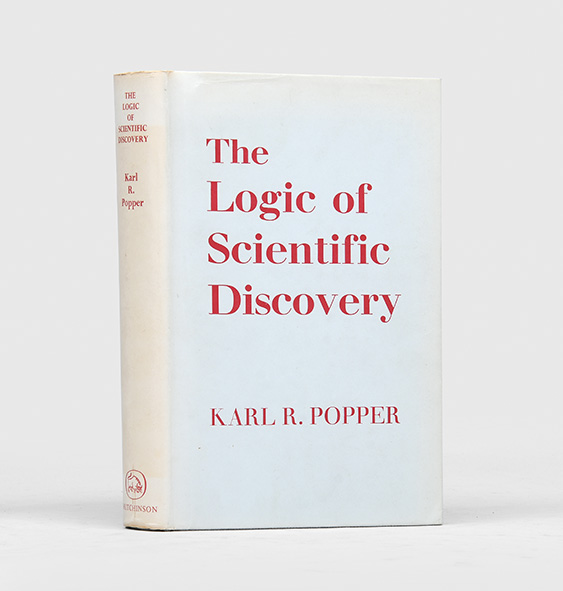
The Logic of Scientific Discovery.
POPPER, Karl R. First edition in English, first impression, of one of the most significant works in the philosophy of science. For the translation, Popper extensively rewrote the text, with new footnotes and 150 pages of new appendices. The work was first published in German in 1934; the English translation was published in the UK in January 1959, preceding the US edition in March. Octavo. Original grey cloth, spine lettered in gilt on red ground, light grey endpapers, top edge red. With dust jacket. Tables, diagrams, and manuscript facsimiles in the text. Unclipped jacket with hint of sunning to spine and a couple of tiny nicks: a fine copy in near-fine jacket.- $1,671
- $1,671
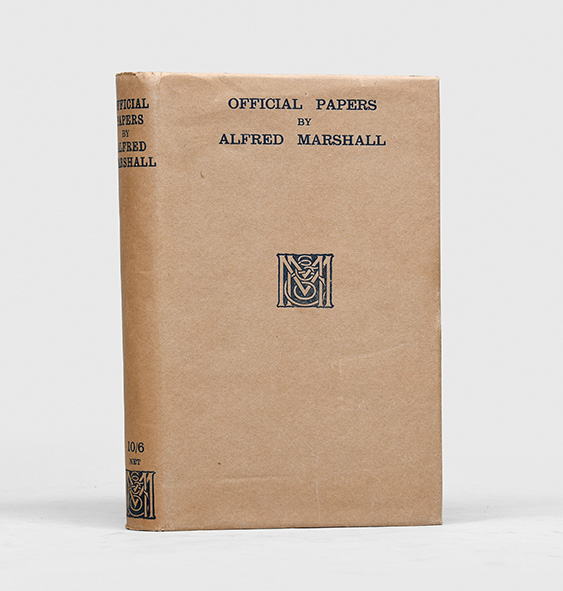
Official Papers.
MARSHALL, Alfred. First edition, first impression, of the author's collected contributions to public enquiries on economics, including a preface by its editor, John Maynard Keynes. Marshall prepared evidence for various enquiries covering poverty, currencies, tariffs, and international trade. Octavo. Original green cloth, spine lettered and ruled in gilt, covers ruled in blind. Tables in the text. Unclipped jacket with a hint of creasing, else: a fine copy in fine jacket.- $501
- $501

Sepher Masoreth
Edited by Joseph Ibn Rai. 8vo. Leather-backed red cloth. Printed by Giovanni di Gara, Venice 1607. First Edition. Text in Hebrew.The Masorah provides the number of times a particular word appears in the Bible. In his Bible commentary, the great Medieval Jewish scholar Jacob ben Asher sought to expound the significance of this phenomenon. This present work provides further studies utilizing this approach, thus reaffirming Jacob ben Asher's earlier efforts. According to many, Jacob moved to Spain with his father. It is also said that Jacob succeeded his father as the rabbi of the Jewish community of Toledo (Zacuto), while others say his brother Judah ben Asher did so. His brothers were also rabbis of different communities in Spain. He lived in abject poverty most of his life, and according to the Sephardic Community of Chios, is said to have fallen ill and died with his 10 companions on the island of Chios, in Greece, while travelling. Small repair to lower corner of title page, edges trimmed, one small closed marginal tear, generally clean internally.- $1,250
- $1,250
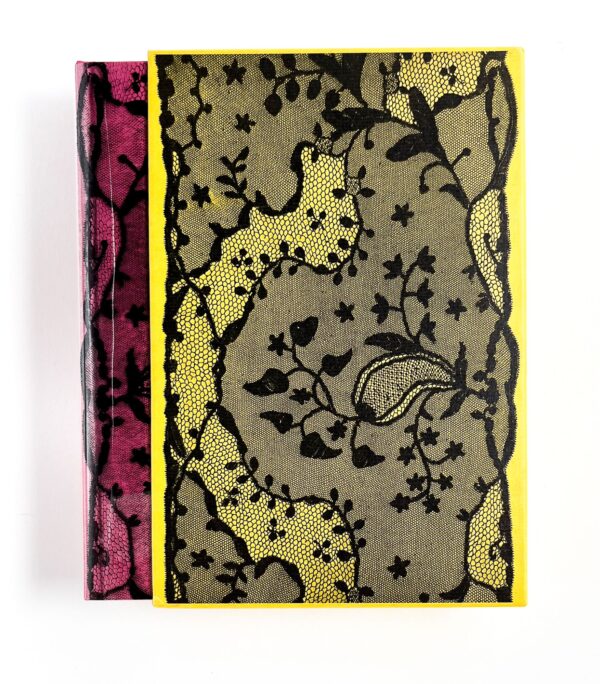
LOVE IN THE TIME OF CHOLERA
García Marquez, Gabriel Signed limited first English edition of García Marquez's ode to the persistence of romantic memory. Gorgeously designed edition of the author's acclaimed novel, first published in Spanish in 1985. The English translation was praised by Thomas Pynchon to the utmost reaches of superlative adjectives, and was the recipient of less frenzied but still glowing compliments from Michiko Kakutani. García Marquez's theme - romantic love that never fades, vows never broken; or, seen another way, the nightmare impossibility of permanently dismissing a determined suitor - struck Pynchon as "revolutionary," though his judgment that working in "love's vernacular" is a "daring step for any writer" may raise eyebrows among those familiar with genres and modes of writing in which these themes and treatments have never fallen out of fashion. García Marquez himself once said, with perhaps greater perception, that the revolutionary part of writing consists simply of doing it well: and he did. A beautiful copy of this signed limited US edition, which preceded the UK edition by several months. 9.25'' x 6.25''. Original quarter pink cloth with black cloth boards, gilt-stamped spine. In original decorative black lace-printed mylar protective jacket. With original yellow and black slipcase. Bright pink endpapers, fore-edge machine deckle. Translated from the Spanish by Edith Grossman. [10], 348, [4] pages. Signed by Garcia Marquez at colophon and numbered 107 of 350 signed and numbered copies of the first edition. Bright, sharp, clean, and tight overall. Fine in fine jacket and slipcase.- $5,000
- $5,000

Druidism The Ancient Faith of Britain
Wright, Dudley FIRST EDITION. Quarto, pp. [8], 192. 9 monochrome plates including frontispiece of "The Massacre of the Druids"; tail-pieces to each chapter. Publishers' green cloth with gilt titles to spine, and titles in black with framed trilithon motif blocked in black to upper board. Fore- and lower-edges uncut. Covers slightly surface soiled, and a little bruised to edge but bright. Attractive Art Nouveau pictorial bookplate of Arthur E. Baker to front paste-down. Scattered light foxing, mainly to prelims and textblock edge otherwise contents clean with no annotation or inscriptions. Study of the ancient religion, its ceremonies, temples and festivals, and its affinity with other faiths. Scarce.- $241
- $241

Les Facécieuses Nuicts (sic), Du Seigneur Straparole.
STRAPAROLA (Giovanni Francesco) 2 vol. in 12, de 1f. 426pp. 3ff. & VIII-451pp. 2ff. (1f. de titre de 2e partie après la p.136), pl. maroquin vert époque, dos lisse orné, encadrement d'un triple filet doré sur les plats, dentelle int., tr. dorées. Bon exemplaire en maroquin du temps. Rare. C'est la traduction de référence de l'oeuvre majeure de Straparola. Elle est due Jean Louveau et Pierre de Larivey. Les éditions anciennes sont rares. C'est un recueil de 75 histoires contées pendant 13 nuits de Carnaval et ou la fantaisie la plus débridée se mêle à la licence des situations, le tout dans un style populaire. Chacune des 13 nuits se termine par une énigme en vers. Rappelons que Perrault y a largement puisé pour ses Contes, mais aussi Mme d'Aulnoy et les frères Grimm. Brunet V.560 - Viollet-Leduc p.117 "Cette édition de 1726 a été revue par de La Monnoye, qui y a ajouté des remarques sur les sources où Straparole avait été puiser ses sujets".- $1,124
- $1,124

La langue des calculs, ouvrage posthume et élémentaire, imprimé sur les manuscrits autographes de l’auteur, dans lequel des observations, faites sur les commencemens et les progrès de cette langue, démontrent les vices des langues vulgaires etc.
CONDILLAC (E. Bonnot Abbé de) 2 parties en 1 vol. in 12, de 1f. 231pp. 2ff. d'ont l'errata & 1f. 250pp. 1f., pl. basane racinée époque, dos lisse orné, dentelle dorée sur les plats, bel exemplaire. (ex-libris mss. F.L. Barville, officier aux gardes). Véritable édition originale séparée, et non comme tome XXIII des oeuvres complètes. Cet ouvrage posthume est l'un de ceux qui eurent le plus d'influence sur la philosophie des sciences au XIXe siècle. Comme ses prédécesseurs dans la tradition rationaliste, Condillac regarde les mathématiques et leur langage comme modèle de connaissance. L'algèbre est ici considérée comme un modèle de langage bien fait et de modèle d'analyse. ¶ DSB II,383 - Honeyman n° 745.- $843
- $843
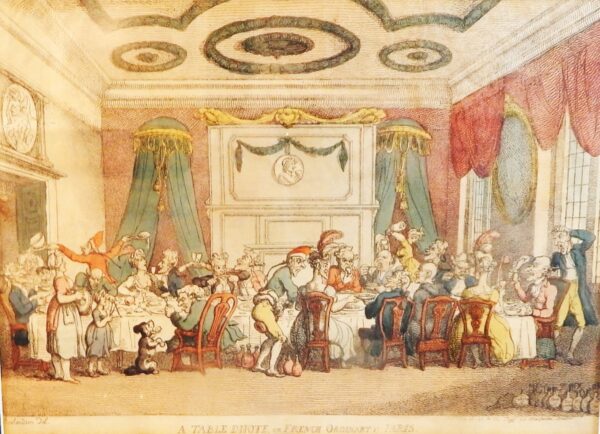
A Table d’Hote or French Ordinary in Paris
Rowlandson, Thomas Hand-colored etching approximately 9-5/8 by 13 5/8 inches. Published on May 30, 1810. Framed and glazed in a simple antiqued gold wooden frame with a hunter green mat. Not examined out of frame but appears to be in fine condition. Frame size is 17 by 21 inches. There appears to be a short manuscript inscription along the left edge of the print. Guests at dinner around a long table in an ornate room. Two men and a woman serve wine, one of them men pulling a cork and the other two spilling the wine. Another waiter spills soup on the head of a guest, wile a woman and child play a tambour and triangle as their dog begs for food. Bottles of various kinds of wine are seen on the floor in the lower right. Scarce Rowlandson original caricature. .- $1,150
- $1,150
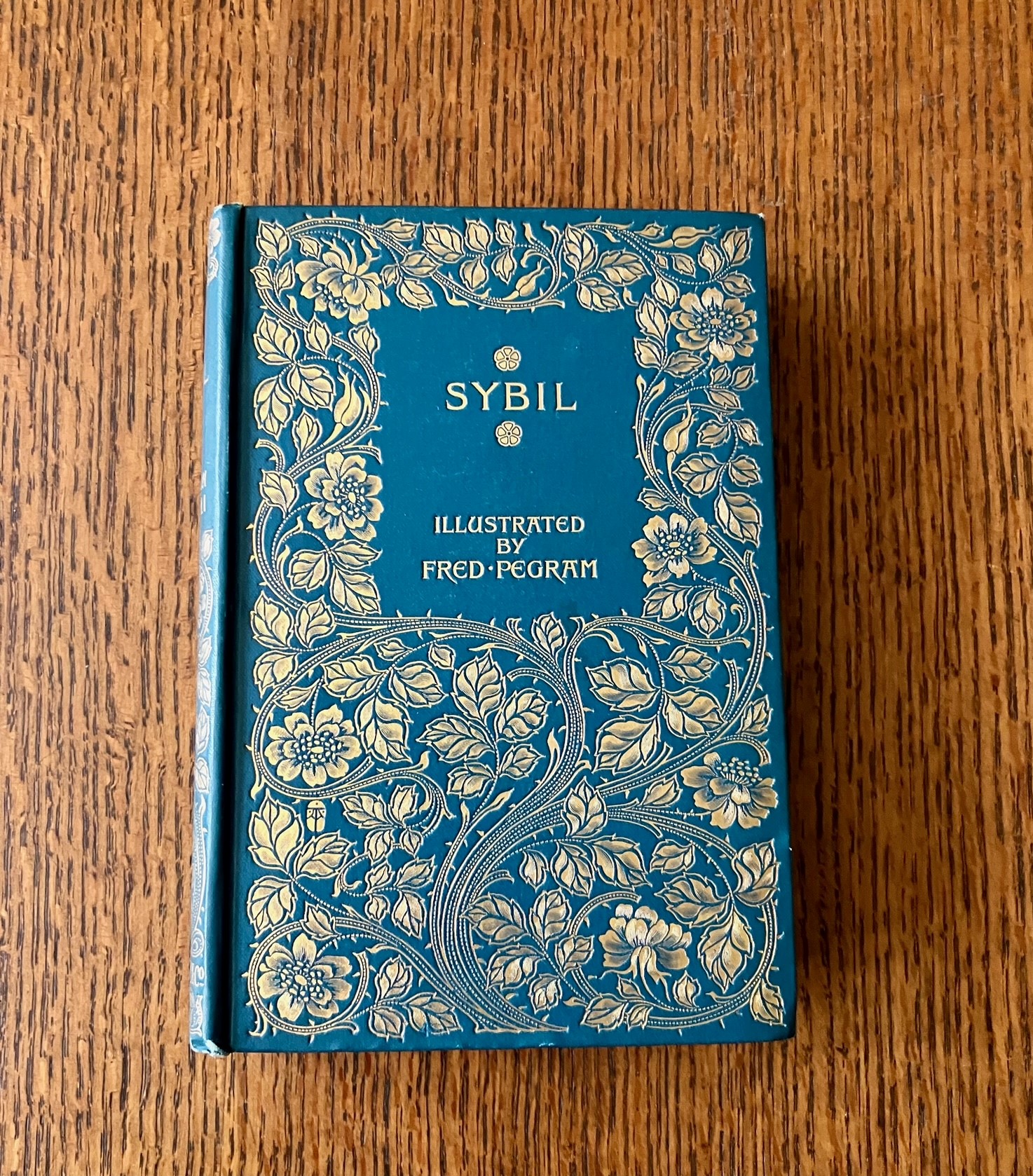
SYBIL. Or The Two Nations. With an introduction by H. D. Traill.
DISRAELI. BENJAMIN. -- PEGRAM, F. Illustrates. FIRST PEGRAM ILLUSTRATED EDITION. 8vo. (7.4 x 5.1 inches). Fully illustrated throughout with 40 fine drawings by Frederick Pegram, most full page. Neat previous owners name to the top of the title page otherwise a fine copy in the publishers delux binding of highly decorative dark blue cloth binding with gilt lettering and illustration by Albert Angus Turbayne to front board and spine. Yellow peacock design on white endpapers. All edges gilt. A fine and smart copy of this scarce beautifully illustrated book. -- More photos available on request.- $201
- $201

SENSE AND SENSIBILITY. With an introduction by Austin Dobson.
AUSTEN. JANE. ; Thomson. Hugh. Illustrates. FIRST HUGH THOMSON EDITION. 8vo. (7.8 x 5.4 inches). Illustrated with 40 full page line drawings. Publishers 6pp of adverts at the end, dated December 1895. Publishers original burgundy cloth with decorative blind stamped floral design to both boards, the front board lettered and ruled in gilt. Spine ruled and lettered in gilt. Page edges untrimmed. A neat previous owner name to the top of the half title page otherwise a very good, bright copy throughout. The cloth is faded to the spine and has some bumping and rubbing to the edges. Overall still a very good copy of this beautiful book.- $401
- $401
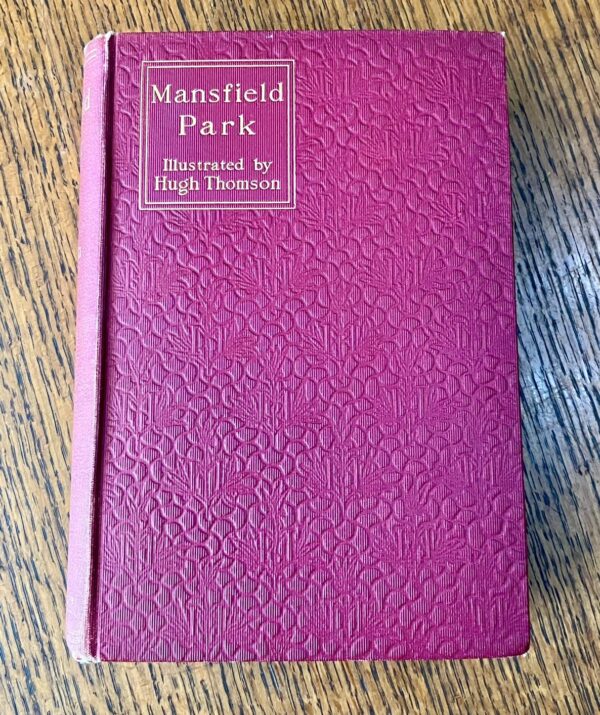
MANSFIELD PARK. With an introduction by Austin Dobson.
AUSTEN. JANE. ; Thomson. Hugh. Illustrates. FIRST HUGH THOMSON EDITION. 8vo. (7.8 x 5.4 inches). Illustrated with 40 full page line drawings. Publishers original burgundy cloth with decorative blind stamped floral design to both boards, the front board lettered and ruled in gilt. Spine ruled and lettered in gilt. Page edges untrimmed. A crisp, clean and bright copy throughout. There is a little fading to the spine and the corner tips are a little rubbed, otherwise this is a near fine copy of this beautiful book. Becoming increasingly difficult to find in collectable condition in the publishers cloth.- $635
- $635
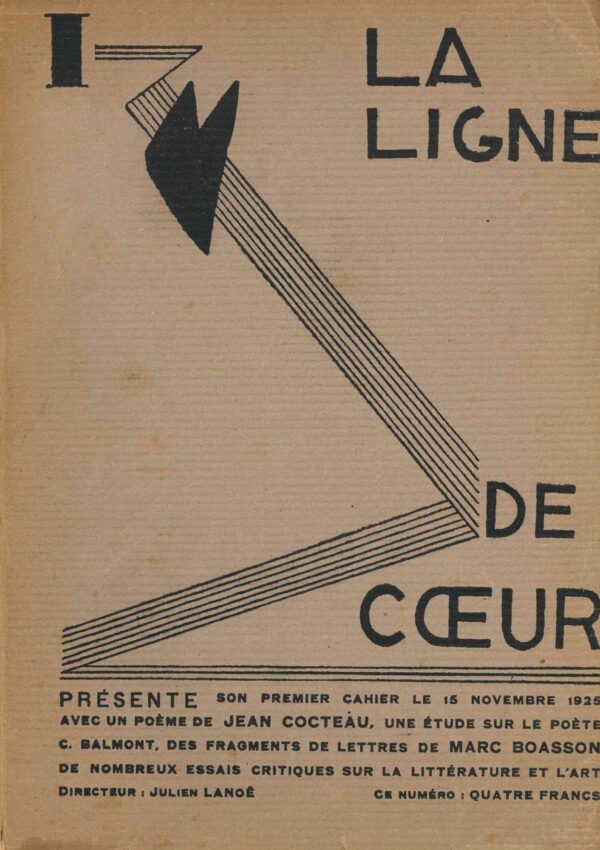
La Ligne de Coeur. Revue mensuelle. First series, No. 1 (November 1925) through 12 (Mars 1928) and Second series, No. I (Mai 1933) through V (Mai 1935) (all published)
A complete run in 17 total issues of the rare avant-garde literary journal. Octavo (8 x 5 5/8 and 8 3/4 x 5 1/2 inches). Original pictorial wrappers (first series) and original printed self-wrappers (second series). Covers of first issue detached, small loss to front cover of second issue, overall very good. Nantes: self-published, 1925-1928 and 1933-1935. This collection comprises a rare complete run of the literary avant-garde journal edited by Julien Lanoë (1904-1983), French writer and industrialist, and President of the Society of Friends of Musée des Beaux-Arts in Nantes from 1936 to 1970. Issues of the first series range from 62 to 72 pages, and the second series from 8 to 16 pages. The issues are comprised of prose and poetry, with contributions from Jacques Maritain, Maurice Fombeure, Robert Garric, Jean Cocteau, Marc Boasson, Constantin Balmont, Max Jacob, Jean-Marie Terrien, Henri Barbot, Léon Bloy, Roger Lesbats, Georges Hugnet, Claude Cahun, Victor-Emile Michelet, Maurice Sachs, Louis Émié, Pierre Menanteau, André de la Perrine, Jules Supervielle, André Salmon, Gabriel Marcel, Jean Aurenche, Philippe Thual, Alfredo Gangotena, Paul Sabon, Louis Guilloux, Pierre Colle, Edward Millpotts, Pierre Reverdy, Giorgio de Chirico, Georges Syam, André Gaillard, and others. Issue no. 4 contains the first printing of an important and often-quoted article by Claude Cahun, titled "Carnaval en chambre". In the brief four-page essay, she deals with the theme of the mask in art and society. Scarce; as of April 2024, OCLC shows holdings at four North American libraries, not all of which are complete runs.- $2,500
- $2,500
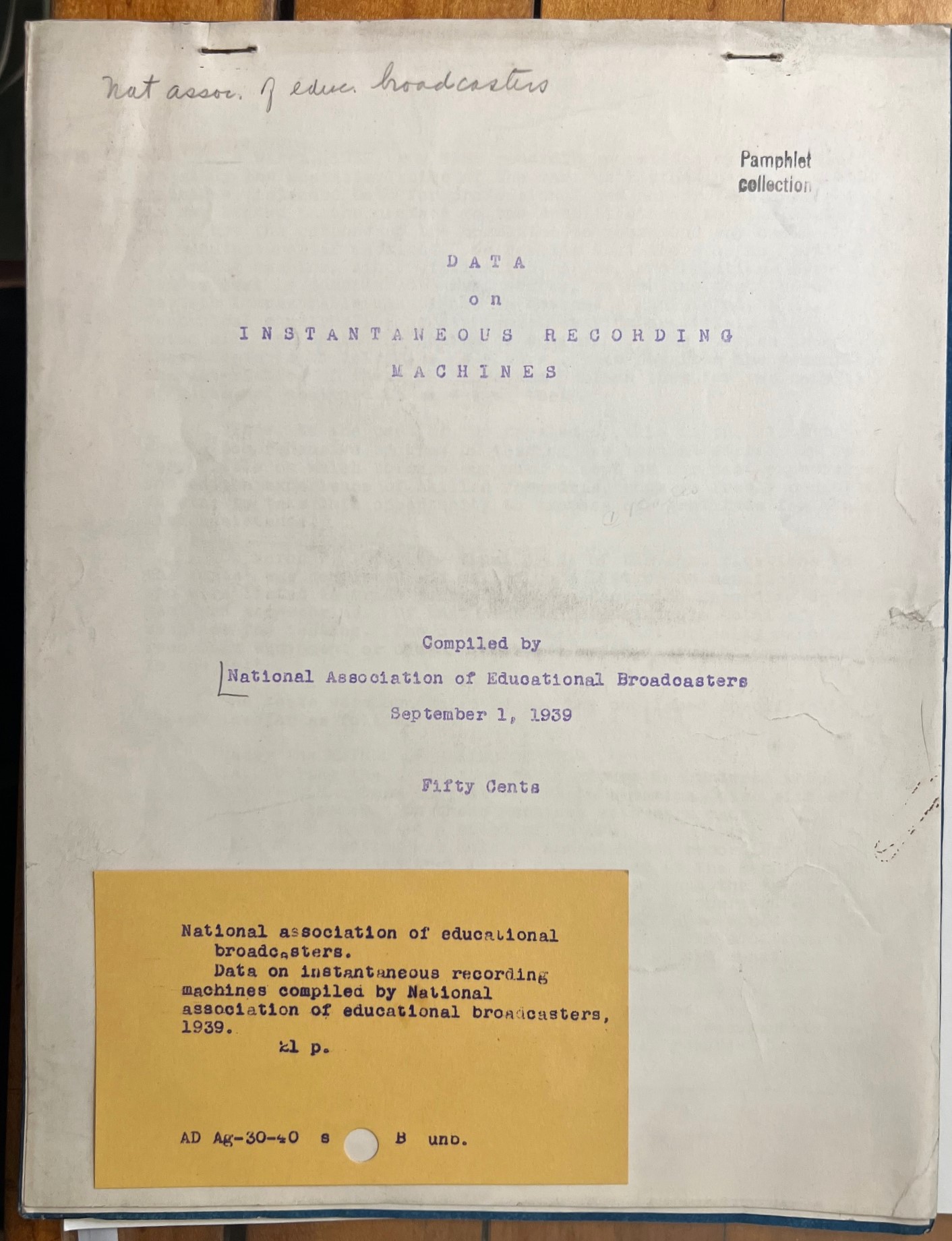
(Audio Recording) Data on Instantaneous Recording Machines
National Association of Educational Broadcasters. **NO Copies listed in WorldCat** (Audio Recording) Data on Instantaneous Recording Machines compiled by the National Association of Educational Broadcasters, September 1, 1939. 11"x8.5" 21 leaves with 4 plates of blueprinted graphs of frequency response curves and etc. Stapled at top. Printing seems to be mimeograph. Provenance" Library of Congress, with their small "Pamphlet Collection" stamp at top right corner and surplus rubber stamp on rear page. VG copy. Interesting document reviewing the state-of-the-art auto recording devices at a still-young period of this technology. [++] No copies found in WorldCat.[++] Comes with a nice piece of LC ephemera--a carbond copy of the LC card catalaog crd (or one of them, at least)- $200
- $200

Future Florida Governor, James E. Broome, Signs 1845 Document As Probate Judge
JAMES E. BROOME JAMES EMILIUS BROOME (1808-1883). Broome served as the third Governor of Florida between 1853 to 1857. DS. 2 pg. 8" x 10". November 19. 1845. N.p. A document signed "J.E. Broome". The front of the document is the "Sales of Cotton?for asc and risk of Estate of John W. Gotten deceased by Henry Waring & Son". Before serving as Florida's Governor James E. Broome was Probate Judge of Leon County between 1841-1848, and as such he was required to certify wills and estate sales such as that of John Gotten. After calculating the sale of cotton as $2611.45 and deducting related expenses, Broome certifies a profit ("net proceeds") of $2219.05. The reverse lists other sources of income and deductions (generally outstanding debts to other individuals) from the "Estate of John W. Gotten deceased", and the final value ("balance") of the estate is listed at $1608.89. This would equal over $60,000 in value today. This document is an excellent example of a typical Southern planter's estate and sources of income and costs in the 19th century. The document is in fine condition with some creases along the edges.- $150
- $150

Contemporary Manuscript Copy Of The Quadruple Alliance Treaty Of 1718
(QUADRUPLE ALLIANCE TREATY OF 1718) (QUADRUPLE ALLIANCE TREATY OF 1718). AM. 71 pg. 7" x 14". August 2, 1718. London. A contemporary manuscript copy of the Quadruple Alliance Treaty of 1718. This copy is believed to be that of William Wake, Archbishop to Canterbury and one of the signatories to the original treaty. This document also includes the signature of "Georgius R". British King George I was one of several Western European royal leaders that was a party to this treaty, which launched war against Spain. In 1713, the Peace of Utrecht had ended the War of Spanish Succession upon the king of Spain, Philip V to retain the Spanish throne in exchange for renouncing the French throne and holdings in modern-day Italy to Hapsburg Austria. However, by 1717, the Spanish monarchy desired to expand and successfully seized Sardinia in October 1717, followed by an invasion of Sicily the next year. In response, Great Britain, France, the Dutch Republic, and Hapsburg Austria created the Quadruple Alliance, which this treaty codified. Written in Latin and signed in London, the Treaty of London was a mutual defense pact between these four powers with the goal of restoring the pre-1717 boundaries in Western Europe. Signatories included King George I of Great Britain, King Charles VI of the Holy Roman Empire, and King Louis XV of France. Over the next two years, a world war broke part between Spain and the Quadruple Alliance, which included a failed Irish invasion of Great Britain sponsored by Spain, a failed Spanish invasion of Brittany France, the French capture of Spanish Pensacola, and an Austrian attack on Spanish forces in Sicily, among other theaters of war. In the end, the conflict ended with the Treaty of The Hague on February 17, 1720, which resulted in Spain ceding all territory gained since 1717 in exchange for France returning Spanish territory it captured. This conflict is notable for the final alliance between Britain and France until the 19th century, for France subsequently allied with Spain in the Bourbon Compact. Spain would regain Sicily during the War of Polish Succession in 1735. This copy is written in Latin, folio on gilt edged paper, and sewn together in book form. It is in good condition, though the binding is aged.- $750
- $750

George Gershwin Endorses Simon Bucharoff’s The Modern Pianist’s Text Book In 1931 Letter
GEORGE GERSHWIN GEORGE GERSHWIN (1898-1937). Gershwin was an American composer and pianist whose compositions spanned popular, jazz, and classical genres. TLS. 1 pg. 8" x 10". March 31, 1931. New York. A typed letter signed "George Gershwin" to "Mr. Simon Bucharoff": "I've been looking through your book called A [sic] MODERN PIANIST'S TEXT BOOK and fine that it is practically complete, from a pianist's standpoint. If I were to go on tour playing the piano, I feel that your book would be the only one necessary to take along, so far as developing and keeping up the technique is concerned. I will be happy to recommend your book wherever possible. Good luck to you". Simon Bucharoff (1881-1955) was a Russian-American pianist, composer, and educator who lectured and taught on the piano and musical composition. His textbook on the piano was published in 1931, and Gershwin's endorsement surely would have been used for marketing and commercial purposes. The same year this letter was sent, Gershwin's Of Thee I Sing became the first musical comedy to win the Pulitzer Prize for Drama. The letter is paired with a black-and-white image of Gershwin. Both are mounted on white in a black wooden frame. All are in fine condition, though the letter has some folds, and the signature is somewhat light.- $4,000
- $4,000

Pictures of English Landscape. (Engraved by the brothers Dalziel) with Pictures in Words by Tom Taylor.
FOSTER, Birket. 4to, pp. ff. [5], 30, [1], each text leaf with corresponding wood engraved plate. Gutta percha perished and a few gatherings loose or separating. Brown cloth, gilt. One small tear to spine, no loss. Ownership inscription of Robert Blackie and bookplate 'Blackie & Son Limited Private Library. [Not in King Victorian Decorated Trade Bindings.]- $201
- $201

Der Traum
Marc, Franz Farblithographie nach dem Ölgemälde von Franz Marc, erschienen als Kunstbeilage in,Derriere le Miroir' 1962 in Paris. Das original Gemälde war ein Geschenk Marcs an Wassily Kandinsky (18661944) im Tausch gegen dessen Gemälde "Improvisation 12". Gefaltet erschienen. Faltung zu erkennen. Im Druck signiert. 37.8 x 56 cm (15 x 22 inches).- $219
- $219
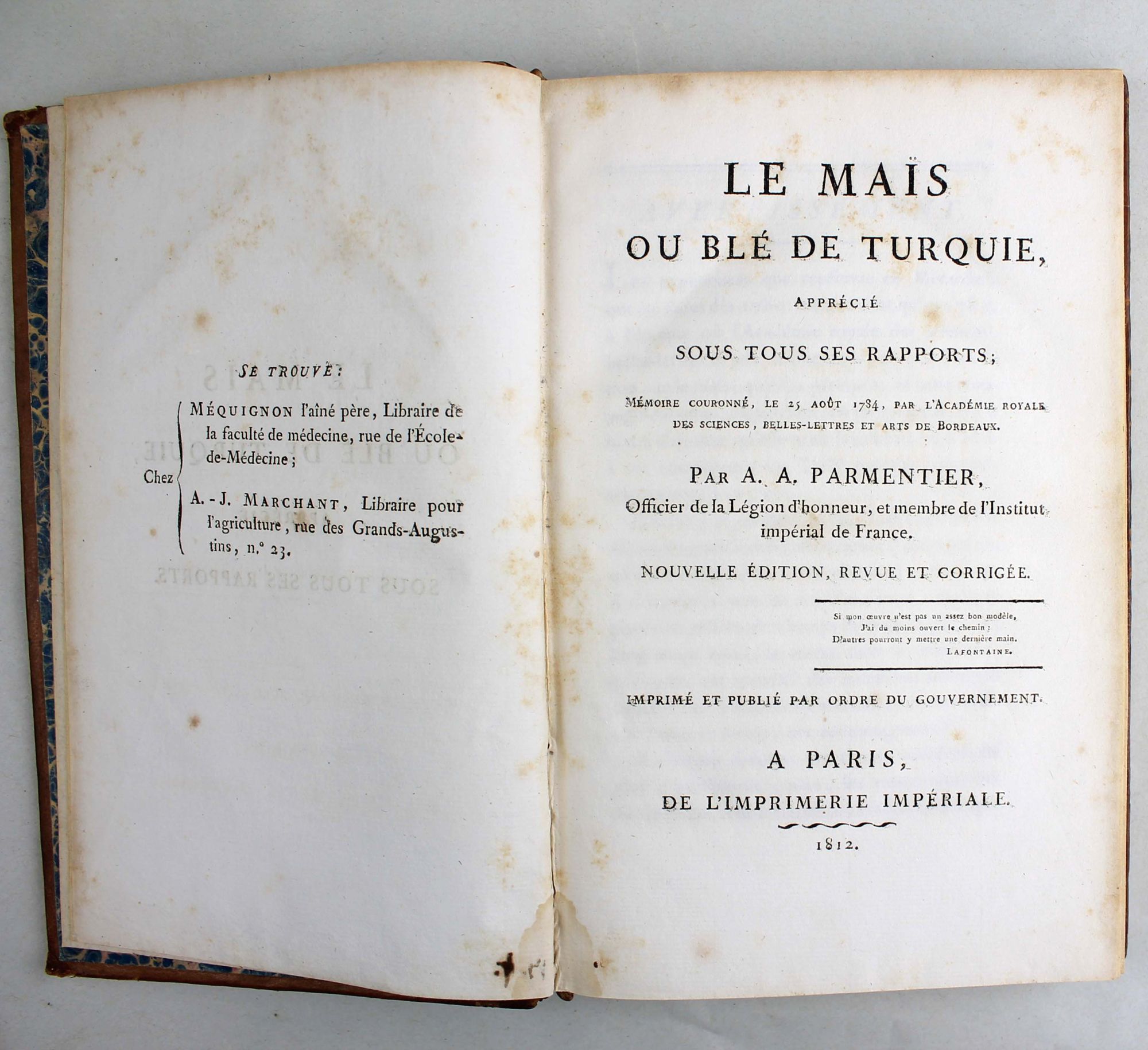
Le maïs ou blé de Turquie, apprécié sous tous ses rapports ; mémoire couronné, le 25 août 1784, par l’ Académie royale des Sciences, Belles-lettres et Arts de Bordeaux
PARMENTIER, A. A. *** Seconde édition, revue et augmentée de plusieurs chapitres. Ce mémoire avait été imprimé une première fois en 1784 par l'Académie de Bordeaux "mais à un si petit nombre d'exemplaires, qu'il a été impossible de le mettre en vente", lit-on dans la préface de Parmentier. Variétés du maïs, culture, recettes de pain de maïs, boissons, maïs-légume, polenta, potages, gâteaux, biscuits, galettes. On a relié dans cet exemplaire, après la préface, une pièce rare : "Notice biographique sur M. Antoine-Augustin Parmentier" par A. F. Sylvestre. (P., Huzard, 1815). 22 pp. Défauts aux coiffes, des rousseurs. *** In-8 de VIII, 22, 303, (1) pp. Veau brun raciné, dos orné, encadrement doré sur les plats, tranches jaunes. (Reliure de l'époque.) - - - - - - - - - - - - - - - - - - - - - - - - - - - - - - - - - - - - - - - - - - - - - - - - - - - - - - - - - - - - - - - - - - - - * - -.- $506
- $506

Historical Memoirs of the Irish Bards. Interspersed with Anecdotes of, and Occasional Observations on the Music of Ireland. Also, an Historical and Descriptive Account of the Musical Instruments of the Ancient Irish. And an Appendix, Biographical and Other Papers, with Select Irish Melodies.
WALKER (Joseph) FIRST LONDON EDITION. 4to, 264 x 197 mms., pp. [iv] v - xii, 166, 124, engraved portrait frontispiece of Cormac Common, engraved head and tailpiece, several engravings in text, engraved plate at end of text block, attractively bound in contemporary mottled calf, with elaborate gilt borders to a floral motif, enclosing a triple gilt rectangular border, with a fan motif at each corner, spine gilt in compartments ( but faded), morocco label; bound without the two pages of music as an appendix, perhaps deliberately, with the binder having neatly excised the catchword and repaired the damage to the paper. Brian Boydell, writing in New Grove, asserts that the Irish antiquary, Joseph Cooper Walker (1761 - 1810), in his book, "though written in a turgid and verbose style, [it] includes much information not available elsewhere, particularlry in relation to the haper Turlouigh Carolan. Five poems and seven airs by Carolan are included in a chapter on his life. It also includes a highly fanciful essay by William Beauford, The Poetical Accents of the Irish, which sought to prove that a system of musical notation was in use in Ireland in the 11th and 12th centuries. In all, 43 Irish airs are included, providing one of the early sources of native Irish music, and a stimulus to its study, which was to bear fruit shortly afterwards in the work of Edward Bunting." Boydell's remarks are not that different in kind from those in the Monthly Review for December 1787: "The present rage for antiquities in Ireland surpasses that of any other nation in Europe. The Welsh who have no contemptible opinion of the antiquity of their poetry and music are left among the children of the earth by Mr. Walker and the writers of the Collectanea de Rebus Hibernicis. Indeed, there is no antiquity short of the creation that can justify these authors." Morris, H. B. (2004). Joseph Cooper Walker, Esq. (C. 1761-1810), A Forgotten Irish Bard: A Dissection of His Advertisement as a Map to His Melodies. Inquiry: The University of Arkansas Undergraduate Research Journal, 5(1).- $1,103
- $1,103

Advice to Mothers, on the Best Means of Promoting the Health, Strength, Beauty, and Intellectual Improvement of their Offspring; With Instructions Respecting their own Health and Happiness . Interspersed with much original and interesting Matter.
BAILLIE (J,) 8vo, 208 x 127 mms., pp. 318. BOUND WITH: Wesley, John. Primitive Physic: or, an Easy and Natural Method of Curing most Diseases. Burslem: Printed by J. Tregortha, 1812. 8vo (in 4s), pp. 103 [104 blank], followed by six leaves y intended for another medical work. 2 volumes in 1, bound in contemporary sheepskin, black leather label. Two scarce provincially-printed medical books, bound (possibly from the parts, given inscription about binding) in a volume and presented by a Lancashire mother, Penelope Vavasour, to her daughter Julia in the year the latter gave birth to her second child. T he first work is in two sections. The first section concerns itself with matters more physical, with chapters on conduct during pregnancy, a section on childbirth, and proper food for infants; the second with matters more spiritual, with chapters on the origin of pride and vanity, the choice of toys, and books. Library Hub records 2 copies, at the BL and NLS, while Worldcat adds 4 more, 3 of which are in New York: Columbia,NYPL, SUNY, and Virginia. The second work is a reprint of John Wesley's 1747 medical guide printed in the Staffordshire town of Burslem. Library Hub records just a single copy, in the Wellcome Collection, to which Worldcat adds 2 copies, both in the United States: the National Library of Medicine and Wesleyan College, Georgia. To the rear are bound the contents leaves and a leaf from the introduction of an edition of William Buchan's Domestic Medicine; given the similarities in paper and print with the pages that immediately precede it, it seems likely to be from Tregortha's 1812 Burslem-printed edition (two American institutions only in Worldcat), and therefore possibly appended by accident in the print-shop.- $1,471
- $1,471
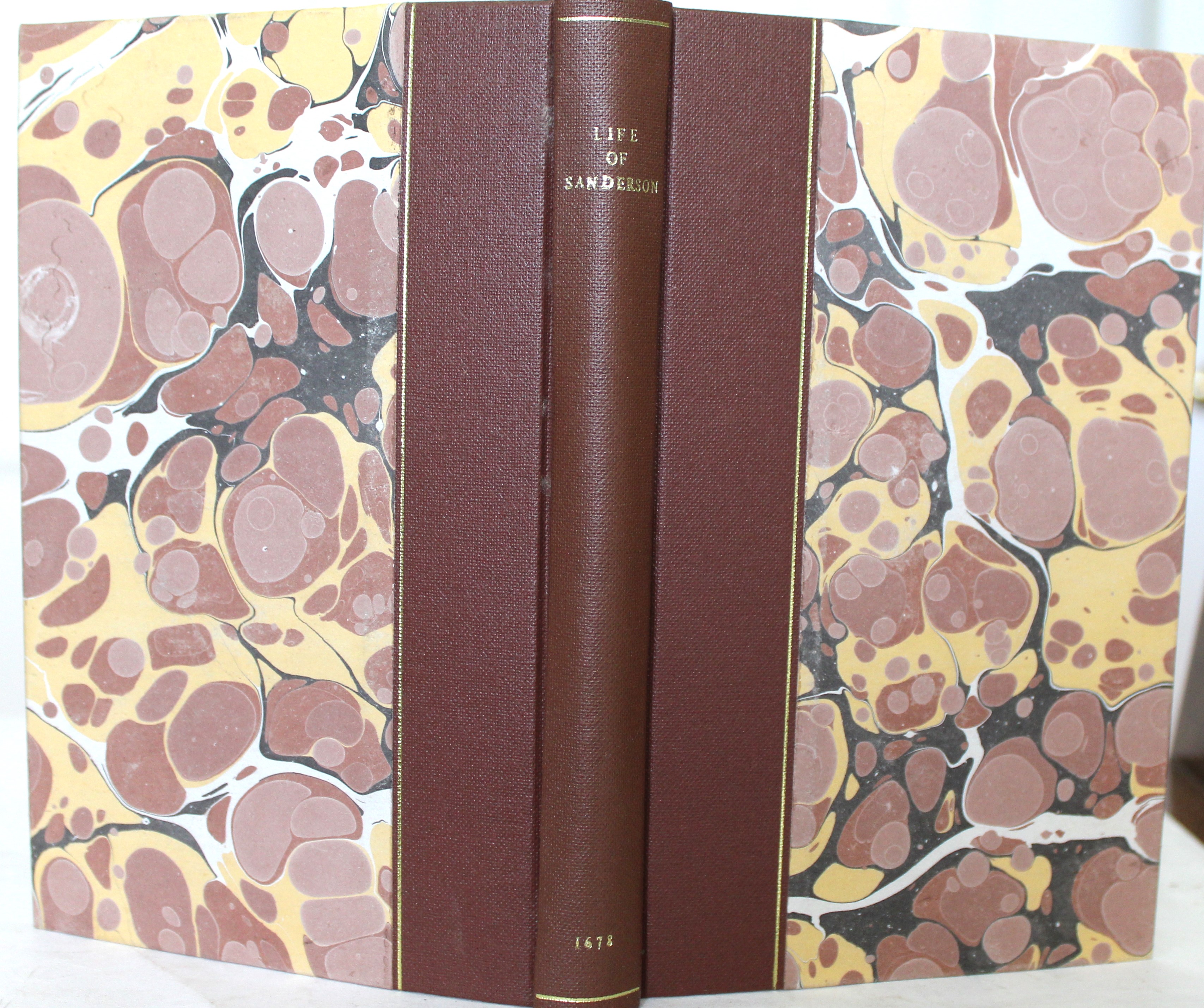
The Life of Dr. Sanderson, Late Bishop of Lincoln. Written by Izaak Walton. to which is added, Some short Tracts of Cases of Conscience, written by the said Bishop
SANDERSON (Robert) . WALTON (Isaac) FIRST EDITION. 12mo, 175 x 108 mms., pp. [240], recently and unsympathetically recased in quarter buckram, marbled boards; lacks portrait. A Calvinist, Bishop Robert Sanderson, (1587-1663) made an impact his contemporaries, including Charles I, as Walton records, "I carry my ears to hear other Preachers', said the king, 'but I carry my Conscience to hear Mr. Sanderson, and to act accordingly." ONDB records, "A doctrinal Calvinist, Sanderson had tried to resolve the controversy created by Richard Mountague's books in the mid-1620s by offering a slight alteration of the sublapsarian doctrine of predestination. Nevertheless, he insisted that the Church of England held that divine act of election was entirely gratuitous and to suggest otherwise was 'quarter-Pelagian and Arminian novelty' (Works, 5.277). Marginal notes condemning the Arminians and 'their Semipelagian subtilties' continued to appear in all editions of his sermons until 1657, and vigorous efforts in the late 1650s by Henry Hammond, Thomas Pierce, and others to change his mind had little success. Sanderson's soteriology, his denunciations of usury and idleness, and his support for the reformation of manners show that he had much in common with puritans. Izaak Walton's biography of Sanderson wholly ignores his Calvinism, his agreement with puritans on many issues, and his quarrels with Hammond and the churchmanship that Hammond and his friends represented. However, throughout his long career he rejected puritan arguments against ceremonies, probably in part because of his observation of the actions of John Cotton and his followers at nearby Boston. Sanderson, deeply concerned to retain protestant unity against Rome, was an anti-puritan in the Whitgiftian mould, an excellent example of the way 'that even men who shared great tracts of ideological terrain with the Puritans could end up hating them with a passion' (Lake, 115)." I suspect that the number of scholars who would be familiar with and under stand the issues, doctrines, and beliefs in those few sentencdes would be very feew.- $221
- $221
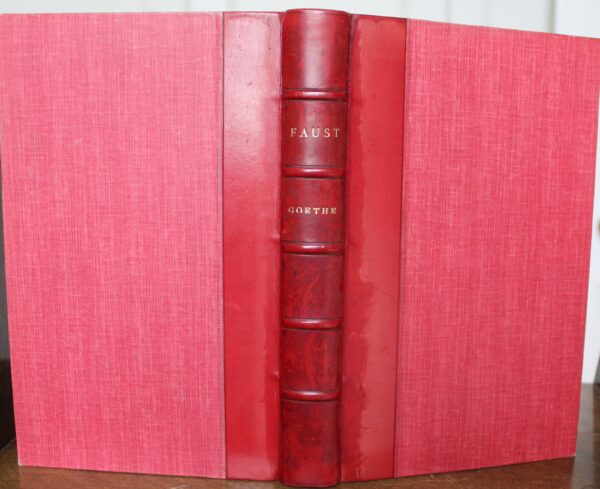
New Idyls by Gessner. Translated by W. Hooper M D. With A Letter to M: Fuslin on Landscape Painting and the Two Friends of Bourbon. A Moral Tale.
GESSNER (Salomon) Large 8vo (in 4s), 270 x 173 mms., pp. [vi], 129 [130 blank], engraved title-page followed by drop-title leaf, 9 full-page enraved plates, 10 engraved tail-pieces, and 2 engraved head-pieces, with later inscription and date,"William Burton/ October 1807" and a transcription of a letter in French by Fuslin to Gessner and Gessner's response on three pages, bound in contemporary calf and expertly rebacked with new red morocco. A very good copy This first translation of Moralische Erzæhlungen und Idyllen (Zurich, 1756) is easily the best-known work of Salomon Gessner (1730 1788), the Swiss artist, poet, government official, etc. The plates are indeed rather splendid. The Monthly Review for 1776 commented, "Perhaps there is no object in poetical criticism that requires a more consummate judgment than to work with certainty the dividing line between what is simple and what is silly. The innumerable errors of this kind, that we have met with confirm the truth of this observation, and it has occurred once or twice on the view of the publication before use." Ah. well: enjoy the illustrations. Martin Bircher, et al., Salomon Gessner: Maler und Dichter der Idylle 17301788. Herzog August Bibliothek, Wolfenbüttel 1982,- $662
- $662
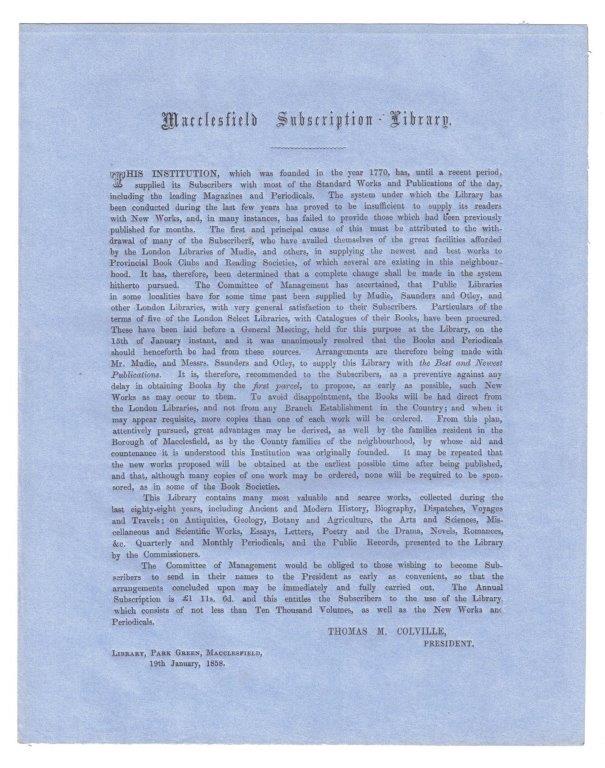
This Institution, which was founded in the year 1770, has, until a recent period, supplied its Subscribers, with most of the Standard Works and Publications of the day, including the leading Magazines and Periodicals. The system under which the Library has been conducted during the last few years has proved to be insufficient to supply its readers with New Works,. The first and principal cause of this must be attributed to the withdrawal of many of the Subscribers, who have availed themselves of the great facilities afforded by the London Libraries of Mudie, and others, in supplying the newest and best works to Provincial Book Clubs and Reading Societies,. Arrangements are therefore being made with Mr. Mudie, and Messrs. Saunders and Otley, to supply this Library with the Best and Newest Publications. It is, therefore, recommended to the Subscribers,. to propose, as early as possible, such New Works as may occur to them. This Library contains many most valuable and scarce works, collec
MACCLESFIELD SUBSCRIPTION LIBRARY. 4to (238 x 188 mm), [4]pp., printed on blue paper, pages [2-4] are blank, signed in letterpress at foot of page [1] Thomas M. Colville, president, Library, Park Green, Macclesfield, 19th January, 1858, a fine copy. A leaflet (printed text on p.[1] only) containing information on the library management and rules for subscribers.- $100
- $100
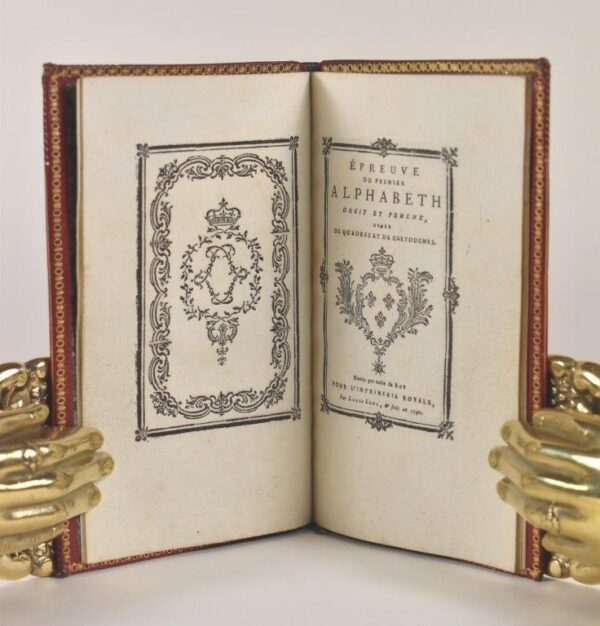
Épreuve du Premier Alphabeth Droit et Penché, ornée de Quadres et de Cartouches.
LUCE (Louis) 32mo (106 x 65 mm), 8ff. early MS. notes to front fly-leaf, marbled endpapers, full contemporary red morocco, small gilt dot tool to corners of both upper and lower board, smooth spine ruled in gilt a lettered direct, turn-in and board edges tooled in gilt, some minor rubbing otherwise a fine copy, housed in a green quarter morocco slip-case. A fine copy of this rare specimen of microscopic type. This specimen presents Luce's "Perle" type in roman and italic (4 point), the smallest type cut to that date. This small specimen contains 3 pages composed exclusively of ornaments, and each page is printed within rules and vignettes. Louis René Luce (c.1695?1774) Type designer, punchcutter and engraver at the Imprimerie Royale, from about 1740 until 1770. He was the third royal engraver of this name, preceded by his father-in-law Alexandre, who had succeeded Philippe Grandjean. "One of the greatest achievements of Louis Luce was his cutting the character which he named "La Perle," which was the smallest body that had ever been cut or cast. [he issued this] specimen of his microscopic type, both Roman and italic, which was cut in emulation of the celebrated Sedanoise editions. Although much smaller, it is nevertheless superior."Bigmore & Wyman. In 1773 all of Luce's work, i.e., 7 typefaces, 8 sets of initial caps, some vignettes, some ornaments, and 15 "poetic" typefaces, were purchased by special command of Louis XV for 100,000 Livres. Provenance: Two bookplates to front endpapers: Ex-libris Le Mis. de Biencourt; "Ex-libris Biencourt-Poncins." Audin, no. 3 ; Birrell and Garnett, p. 16 ; cf. Bigmore and Wyman I, 446. Brunet III, 1204, Graesse IV, 277.- $4,606
- $4,606

The prize: or, the lace-makers of missenden
BARNARD, Mrs. Caroline [4], 167, [1], 12pp. With a half-title, an engraved frontispiece, and a terminal publisher's advertisement catalogue. Contemporary blind-ruled calf, recently rebacked, contrasting morocco lettering-piece. Heavily rubbed, spine sunned. Hinges exposed, recent bookplate of Francis Edwards of Northwood to FEP, offsetting to title, scattered spotting. The first edition of an uncommon, decidedly conservative provincial conduct-of-life novel for children, relating the life in Little Missenden of two teenage Fielding sisters, Rose and Sally, who are participants in an established lace-school and competition. Throughout the novel hard-work, localism and the approval of a philanthropic gentry are the victors over the wily incomers from 'Lonnon'. The conjecture by Emily Sunstein (Mary Shelley: Romance and Reality p.415) that this work and Barnard's Parent's offering (London, 1813) could have been pseudonymous works by Mary Shelley, author of Frankenstein and step- daughter of the publisher, seems unlikely. However, it is nevertheless a great coincidence that Shelley had moved to Buckinghamshire in 1816, and that Claire Claremont - her step-sister - refers to reading a copy of The Parent's Offering, in her journal, whilst living with the couple in Pisa during the summer of 1820. Size: 12mo- $1,671
- $1,671
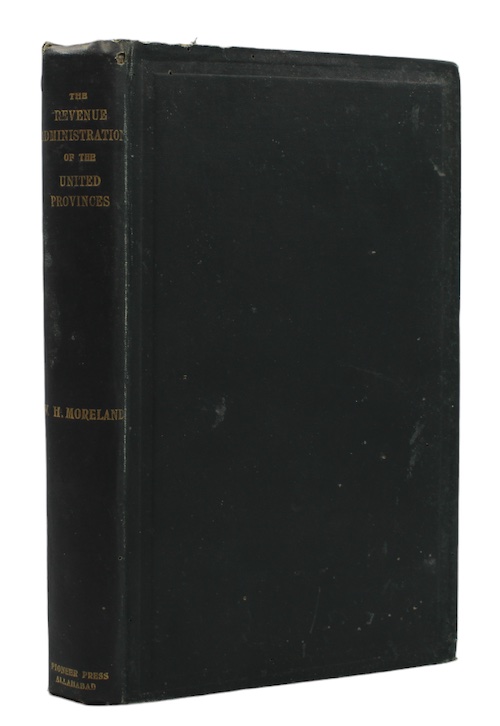
The revenue administration of the united provinces
MORELAND, W. H [4], xiv, 203pp, [1]. Original publisher's blind-stamped green cloth, lettered in gilt to spine. Rubbed and marked, numerous minute wormholes. Ink-stamp of Brajmohan Lal Dave to recto of FFEP, pencilled shelf-marks to head of title, worm-track to lower margin of initial six gatherings, scattered spotting. An authoritative review, by British Civil Servant William Harrison Moreland (1868-1938), of the administration of Uttar Pradesh, most particularly in relation to land tenure and real property tax, compiled for the use of junior officers of the Indian Civil Service. Size: 8vo- $334
- $334
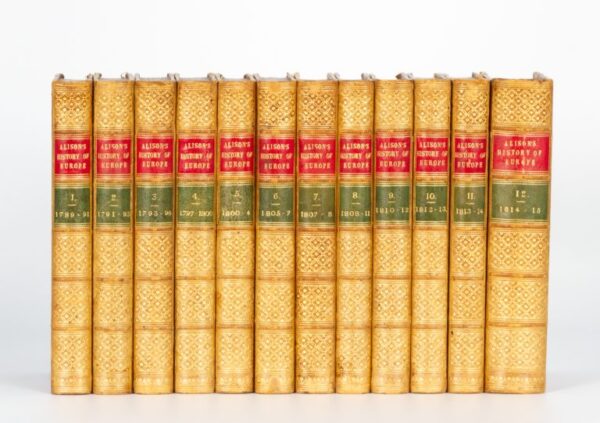
History of Europe
ALISON, Sir Archibald from the Commencement of the French Revolution in M.DCC.LXXXIX. to the Restoration of the Bourbons in MDCCC.XV. Edinburgh and London : William Blackwood and Sons, 1853 - 1855. Ninth edition. Twelve volumes octavo (lacking the oblong quarto atlas), bound in uniform half calf, spine in compartments with raised bands and gilt ornamentation, contrasting morocco title labels ruled in gilt, a few scuffs, marbled edges, pagination various, engraved frontispieces. A very good set of Alison's monumental study of the French Revolution, written to quell any thoughts that such an event could take place in Great Britain. This set lacks the final atlas volume.- $418
- $418

LA JEUNE FILLE VERTE. Illustré de quatorze lithographies de Roger Chastel
TOULET (Paul Jean). Roger CHASTEL illustrateur [1946]. Grand in-4° carré, 240 pages et 2 feuillets de table, en feuilles sous étui. Une suite de 14 lithographies hors-texte en noir sous chemise. Couverture lithographiée en couleurs par l'artiste. Une chemise étui de l'éditeur, un bel exemplaire. L'un des 70 exemplaires imprimés sur Pur Fil DE RIVES avec une suite. COMPLET DE SA SUITE.- $225
- $225
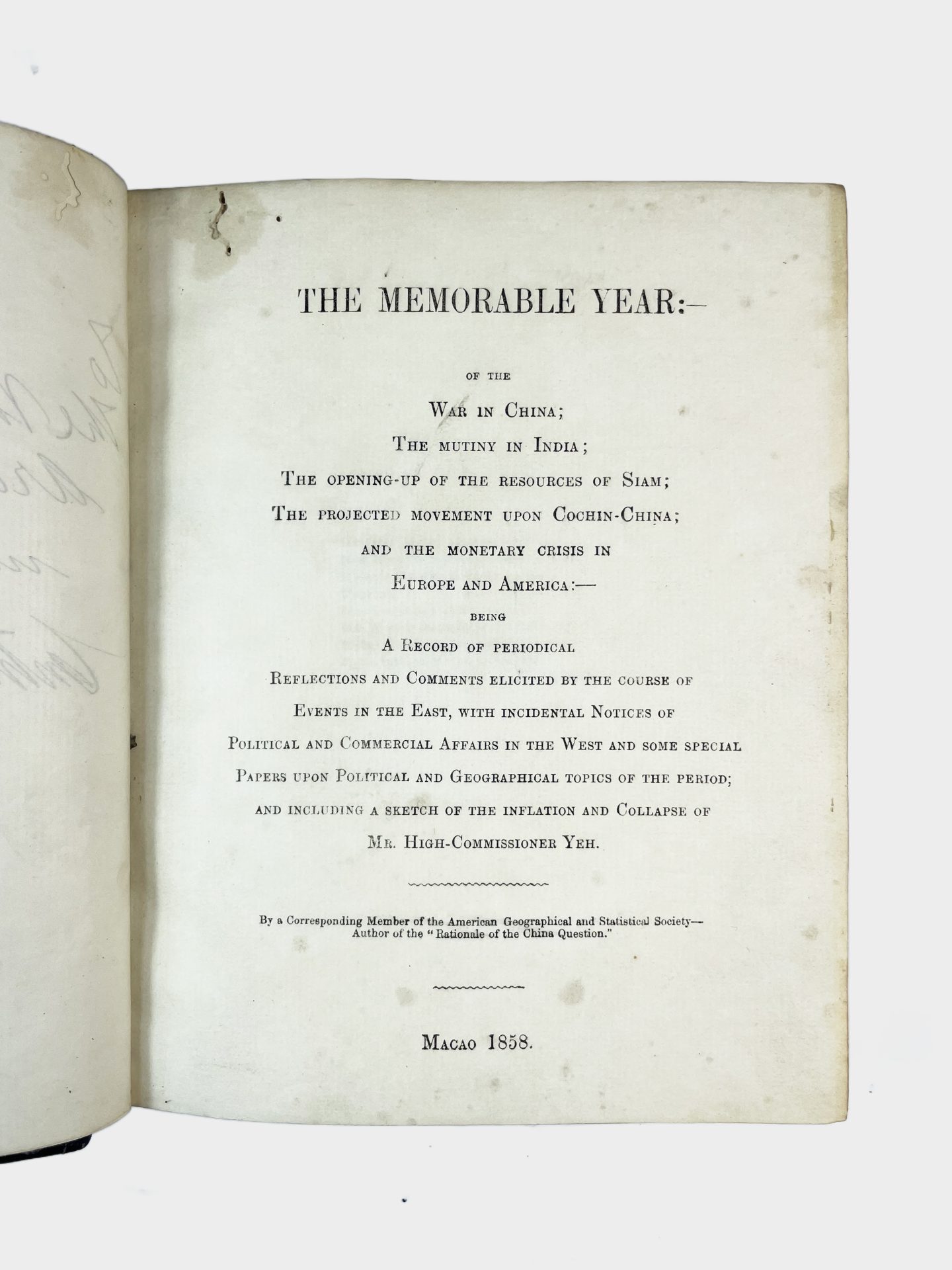
The Memorable Year: -of the War in China, the Opening Up of the Resources of Siam; the Projected Movement Upon Cochin-China; and the Monetary Crisis in Europe and America. By a Corresponding Member of the American Geographical and Statistical Society, Etc
Gideon NYE (1812-1888). Large 8°, [24 pp.] with title, verses, preface, index, 4 blank pages, starting with p. 9 on second text page (complete), 360 pp., pp. A-D between pp. 339-340, contemporary half dark brown calf with gold tooling and lettering on the spine and marbled paper boards, a presentation copy with a dedication by the author in black ink on the first blank page and a later owner's signature in pencil in the upper part "A. Salles, Paris, Oct. 1903" (pp. 318-319 with a tear in the upper white margin, small worm holes in the inner upper corner of the first part, minor sporadic staining, binding slightly rubbed on the corners and in the upper and lower part of the spine, but overall in a good condition) MACAO IMPRINT: A rare book on the events in China, Cochin China, and India, authored by an American diplomat Gideon Nye in Macao, in 1858, and written in a modern style, where the author seeks connections between global events and is not discussing them in isolation. With a dedication by the author to John Gray, the Archdeacon of Hong Kong - Gideon Nye (1812-1888) was an American diplomat, writer and art collector, who arrived to China in 1831 from his native Massachusetts. He lived in Guangzhou and Macao until his death in 1888 and in almost six decades in China, Nye, a corresponding member of the American Geographical Society and an American Vice Consul, authored several books on the region, political events, such as the events which leading up to the First and Second Opium Wars, tea trade and art. A contemporary report describes Gideon Nye as "Nestor of foreign residents in China, publicist, philanthropist and patriot." Chinese Recorder and Missionary Journal, Vol. 19, 1888, p. 525). In this book, printed in Macao in 1858 and addressed to American readers, Nye describes a series of contemporary events, related to China, Cochin China, and India and connects them into a group of global events. The book is dedicated in manuscript on the first blank page by the author to John Gray (1823 1890), the Archdeacon of Hong Kong (1868-1878), and a consular chaplain at Canton (Guangzhou, 186778) and a commissary of the Diocese of Victoria, Hong Kong: To the Venerate Archdeacon Gray with Mr. Nye's Compl[iment]s. Canton 12th March 1870. We could trace about half a dozen institutional examples on Worldcat, the other appear to be microfilms (Harvard Law School Library, Phillips Library (Peabody Essex Museum), University of Wisconsin Milwaukee, The Claremont Colleges, Library of Congress, American Antiquarian Society, The British Library (or microfilm?), Yale University Library (or microfilm?)). References: OCLC 681653924 (also microfilm), 504088286.- $4,256
- $4,256

Gorey Stories: Books & Drawings by Edward Gorey
Poster advertising the titular exhibition at the Minneapolis Institute of Arts, on display from October 26, 1984 to March 17, 1985. Illustrated in four compartments showing three companions and a dog in a rotating array of positions "while sitting around after tea." Fine. Framed. (Frame measures 17 1/4 by 8 3/4 in.) Together with the exhibition catalog, bifold with additional sheet laid in providing a curatorial statement. Signed by Gorey. This with minor bumping to corners, motes of soiling, else very good. (Toledano, p. 169).- $518
- $518
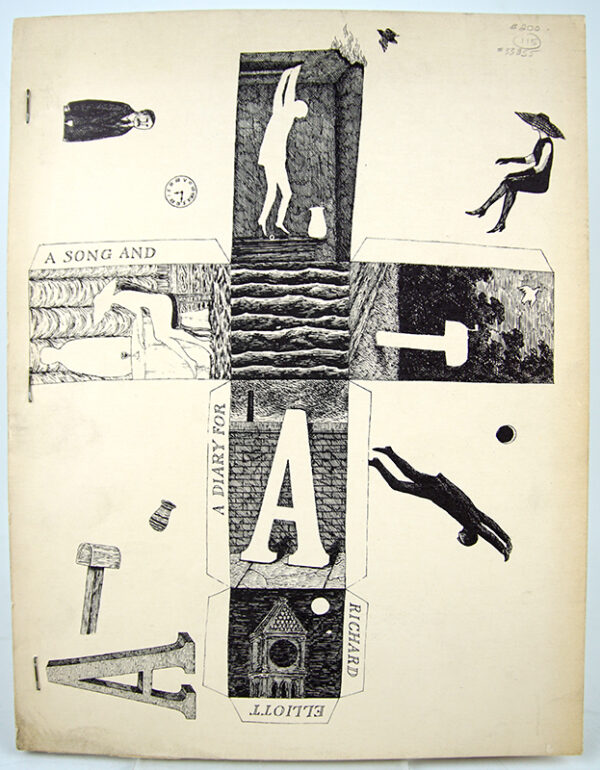
A Song and a Diary for A.
Elliott, Richard Octavo. (60)pp. From an edition of twenty-six copies, this is an apparently out of series copy, unsigned and unnumbered at the colophon. Cover design by Gorey, in the manner of a flat image to be cut out and folded into a cuboid. Printed mimeograph. A rare contribution by Gorey to the storied publishing project at St. Mark's. Staple-bound. Toned overall, as expected, trace soiling and edgewear, else near fine. (Toledano D-Elliott).- $230
- $230
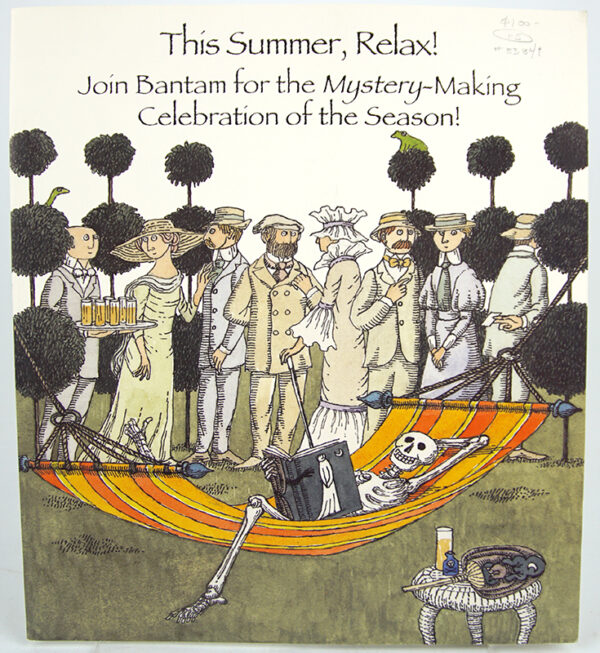
This Summer, Relax!
Square octavo triptych brochure. An advertising giveaway from Bantam, sent to booksellers to entice them with "the opportunity to profit from crime." The brochure's use of colorful Gorey images of a trepidatious summer garden party is paired with nods to Masterpiece Mystery! In addition to new publications, Bantam offers various marketing materials, including a floor display, a lineup of print advertisements, and complimentary bookmarks. Housed in pocket at rightmost panel are a "Map of Mystery," charting book settings and author homes in the United States; a display kit order form; and an entry form to participate in Bantam's window display contest. Mild bumping to corners, faint soiling to rear center panel, else near fine.- $115
- $115
![[Manilla]. Plan De La Baye et Ville de Manille](https://rarebookinsider.com/wp-content/uploads/2024/07/31910516617.jpg)
[Manilla]. Plan De La Baye et Ville de Manille, Capitale des Isles Philippines, Située en L’Isle Luçon, par 14. D.gré 39.m de Latitude Septentrionale, & par 118 D.gré 33.m de Longitude Méridien de l’Observatoire de Paris.
APRÈS DE MANNEVILLETTE, Jean-Baptiste-Nicolas-Denis d' (1707-1780). Original copper-engraved sea chart of Manilla (57.5 x 41.5 cm overall) printed on heavy paper. The chart extends from the North coast of Mindoro Island to north of Pointe de Capones, centered on Manilla Bay and Subec Bay. It is based on the most progressive sources available to the French Navy. European interest in Manila Bay, and the Philippines in general, was heightened upon hearing news of British Admiral George Anson's capture of a Spanish Manila Galleon off of Cabo Espiritu Santo, in 1743. A few isolated spots, generally a very good clean copy. The present chart was drafted by French sailor and hydrographer Jean-Batiste de Mannevillette (1707-80). Mannevillette apprenticed under the great royal cartographer Guillaume De L'Isle. He then joined the maritime service of the Compagnie des Indes, eventually attaining the rank of captain. Upon his return to Paris, Mannevillette was appointed as director of the Dépôt des Cartes et Plans de la Navigation des Indes. In 1745, he published the first edition of his sea atlas of Asian waters, Le Neptune Oriental, regarded as a major achievement and a library indispensable to navigators. The high quality of Mannevillette's charts won him the acclaim of both mariners and academics alike, and he was admitted as a fellow of the Academy of Sciences. He published a second, heavily revised, edition of the Neptune Oriental in 1775., from which the present chart derives.- $1,655
- $1,655

Mittelbach’s karte des Türkischen reiches mit Südrussland, Kaukasus, Persien, Ägypten, Arabien.
MITTELBACH. Original large colour-printed map of the Middle East (94 x 78 cm) focussing on the Arabian Peninsula, with an inset map of the Nile Delta and Suez Canal to upper corner. Folding into publisher's original card wrappers (24 x 15.5 cm) printed in black and red. Photolithographed by Druck. One small patch of browning to Caspian Sea, otherwise an excellent copy preserved in the original wrappers. The map shows the Middle East around the time of the First World War and includes a wealth of detail including railways (including the Hejaz Railway), roads, ruins, forts, cables, steamer lines, etc. European colonial possessions are shaded in dark green (British), yellow (Italian), and orange (French).- $496
- $496

Dunkirk to Berlin. June 1940 – July 1945. A map of the Historic Wartime Journeys undertaken by The Right Hon. Sir Winston Churchill, K.G., O.M., C.H. In Defence of the British Commonwealth and Empire.
(CHURCHILL, Winston); HUNT, Frank A. Devine. Original colour printed map (91 x 117 cm) of the "historic wartime journeys undertaken by the Right Hon. Winston Churchill.in defence of the British Commonwelath and Empire. Folds into original card slipcase (22 x 15 cm) with pictorial front-cover". "Issued to World Book Members in April 1956" printed to back of case. Some crude tape repairs to slip-case, map in excellent condition. The routes of Churchill's wartime trips abroad are shown, noted the conferences he attended and Churchill's mode of transport. Colourful vignette portraits of the planes and ships Churchill used appear at the foot of the map and include HMS Duke of York, HMS Renown, HMT Queen Mary, and the airplanes "Commando" and "Berwick." Churchill's popular six-volume memoir The Second World War, originally published between 1948 and 1954, was reissued in a cheaper edition by the Reprint Society between 1950 and 1956 for its World Books book club. "Upon publication of the sixth and final volume of the Reprint Society edition in April 1956, the publisher issued World Books members a folded slipcased 'Map of the Historic Wartime Journeys undertaken by The Right Hon. Sir Winston Churchill, K.G., O.M., C.H. in Defence of the British Commonwealth and Empire' to commemorate the 'completion of the Reprint Society edition of the Churchill war memoirs'" (Cohen A240.6(VI).a).- $993
- $993
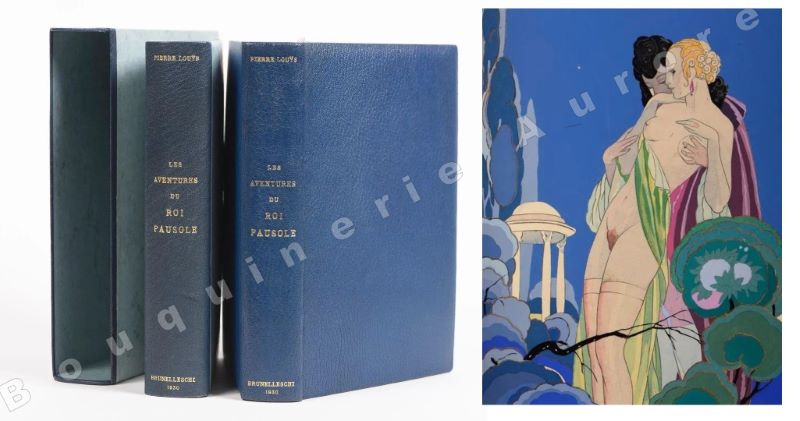
Les Aventures du Roi Pausole. Illustrations en couleurs par Brunelleschi.
[BRUNELLESCHI (Umberto)] - LOUYS (Pierre). 17 illustrations d'Umberto BRUNELLESCHI, (1 frontispice, 8 hors-textes et 8 in-textes), gravées par l'aquafortiste Gorvel, les gravures au trait ont été tirées en noir par Adolphe Valcke et mises en couleurs par le maître du pochoir Jean Saudé. L'impression typographique a été confiée à l'imprimerie Coulouma à Argenteuil.Tiré à 499 exemplaires + 25 H.C., 1 des 5 exemplaires hors-commerce sur Japon Impérial (N°I) comportant une suite en noir des hors-textes et entêtes de chapitres, signée au crayon par l'artiste.On y joint sur feuillets volants, le bulletin de souscription, 4 pp. in-4°, dont 1 hors-texte, légèrement froissé.Du très grand Brunelleschi, le rendu des couleurs est absolument époustouflant sur Japon Impérial, digne des dessins originaux, MAGNIFIQUE.Réf. biblio. : Carteret IV-250 : "Edition recherchée et cotée" - Monod, 7371.- $5,013
- $5,013

Falbalas et Fanfreluches 5ème année – Almanach des modes présentes, passées & futures pour 1926 Le Songe d’Ève – Aquarelles par G. Barbier.
[BARBIER (George)] Baronne de BRIMONT. Tirage unique sur vélin d'Arches à la forme et entièrement illustré par George Barbier (1 couverture, 1 vignette en page de titre et 12 planches coloriées au pochoir et 1 entête en noir). Texte de la baronne de Brimont. Les planches sont titrées : La Terre L'Air Le Feu L'Eau Le Printemps L'Été L'Automne L'Hiver Le Matin Le Soir - Les Cerises Le Modèle intéressant. Rare édition originale d'un des chefs-d'uvre de George Barbier. 5 volumes sont parus entre 1922 et 1926 en remplacement de La Guirlande des Mois.Réf. biblio. : Colas, Bibliographie du Costumes et de la Mode, 1026.- $1,782
- $1,782

Falbalas et Fanfreluches 3ème année – Almanach des modes présentes, passées & futures pour 1924 – Glorifions la coquetterie – Aquarelles par G. Barbier.
[BARBIER (George)] SOREL (Cécile) de la Comédie Française. Tirage unique sur vélin d'Arches à la forme et entièrement illustré par George Barbier (1 couverture, 1 vignette en page de titre et 12 planches coloriées au pochoir et 1 entête en noir). Texte de Cécile Sorel de la Comédie Française. Les planches sont titrées : Le Retour - L'Escarpolette - Le jugement de Paris - Mlle Sorel au Bal du Grand Prix - L'Aveu difficile - Au Polo - La Jolie Insulaire - Comptez sur mes Serments - Sérénade - Sont-ils gentils - Le Baiser dérobé - la Bénédiction Paternelle. Rare édition originale d'un des chefs-d'oeuvre de George Barbier. 5 volumes sont parus entre 1922 et 1926 en remplacement de La Guirlande des Mois.Réf. biblio. : Colas, Bibliographie du Costumes et de la Mode, 1026.- $1,782
- $1,782

Sacha GUITRY – Livre signé – Théâtre – Le Comédien
Sacha GUITRY Sacha GUITRY (1885 - 1957), comédien et dramaturge français Le Comédien, MCMLII (1952) Volume in-4° faisant parti d'un ensemble de douze de la collection illustrée par Georges Lepape des uvres de Sacha Guitry. Edition numérotée 27 sur un total de 92 exemplaires sur chiffon à la forme des Moulins de Faya, filigranée au nom de Sacha Guitry et signée par l'auteur. Certaines pages non découpées. Exemplaire en très bon état ni tâches ni rousseurs.- $168
- $168

Sacha GUITRY – Livre signé – Théâtre – Le nouveau testament
Sacha GUITRY Sacha GUITRY (1885 - 1957), comédien et dramaturge français Le nouveau testament, MCMLII (1952) Volume in-4° faisant parti d un ensemble de douze de la collection illustrée par Georges Lepape des uvres de Sacha Guitry. Edition numérotée 27 sur un total de 92 exemplaires sur chiffon à la forme des Moulins de Faya, filigranée au nom de Sacha Guitry et signée par l auteur. Certaines pages non découpées. A noter une petite déchirure sur la jaquette au coin gauche Exemplaire en très bon état ni tâches ni rousseurs.- $134
- $134

Sacha GUITRY – Livre signé – Théâtre – Toâ
Sacha GUITRY Sacha GUITRY (1885 - 1957), comédien et dramaturge français Toâ, MCMLII (1952) Volume in-4° faisant parti d'un ensemble de douze de la collection illustrée par Georges Lepape des uvres de Sacha Guitry. Edition numérotée 27 sur un total de 92 exemplaires sur chiffon à la forme des Moulins de Faya, filigranée au nom de Sacha Guitry et signée par l'auteur. Certaines pages non découpées. A noter 2 petites déchirures sur la jaquette Exemplaire en très bon état ni tâches ni rousseurs.- $168
- $168

Sacha GUITRY – Livre signé – Théâtre – Une Folie
Sacha GUITRY Sacha GUITRY (1885 - 1957), comédien et dramaturge français Une Folie, MCMLII (1952) Volume in-4° faisant parti d'un ensemble de douze de la collection illustrée par Georges Lepape des uvres de Sacha Guitry. Edition numérotée 27 sur un total de 92 exemplaires sur chiffon à la forme des Moulins de Faya, filigranée au nom de Sacha Guitry et signée par l'auteur. Certaines pages non découpées. A noter 2 petites déchirures sur la jaquette Exemplaire en très bon état ni tâches ni rousseurs.- $168
- $168

Sacha GUITRY – Livre signé – Théâtre – La fin du monde
Sacha GUITRY Sacha GUITRY (1885 - 1957), comédien et dramaturge français La fin du monde, MCMLII (1952) Volume in-4° faisant parti d'un ensemble de douze de la collection illustrée par Georges Lepape des uvres de Sacha Guitry. Edition numérotée 27 sur un total de 92 exemplaires sur chiffon à la forme des Moulins de Faya, filigranée au nom de Sacha Guitry et signée par l'auteur. Certaines pages non découpées. Exemplaire en très bon état ni tâches ni rousseurs.- $168
- $168
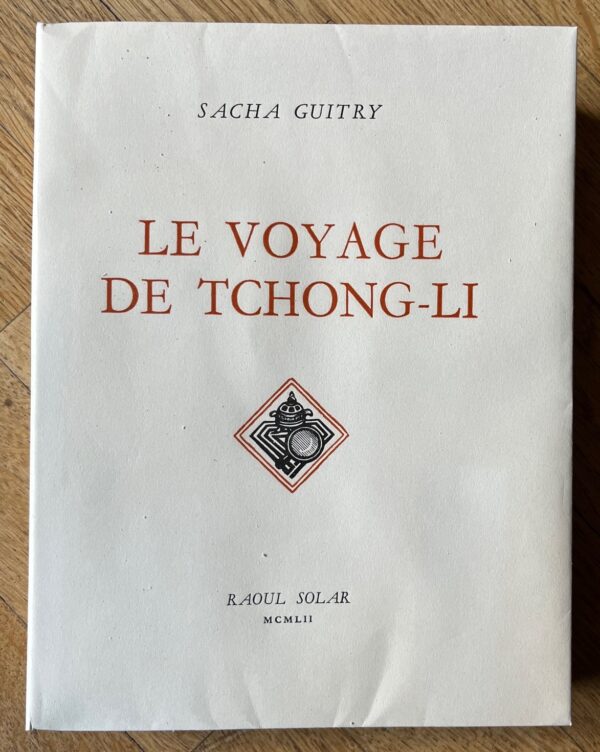
Sacha GUITRY – Livre signé – Théâtre – Le voyage de Tchong-Li
Sacha GUITRY Sacha GUITRY (1885 - 1957), comédien et dramaturge français Le voyage de Tchong-Li, MCMLII (1952) Volume in-4° faisant parti d'un ensemble de douze de la collection illustrée par Georges Lepape des uvres de Sacha Guitry. Edition numérotée 27 sur un total de 92 exemplaires sur chiffon à la forme des Moulins de Faya, filigranée au nom de Sacha Guitry et signée par l'auteur. Certaines pages non découpées. Exemplaire en très bon état ni tâches ni rousseurs.- $168
- $168
